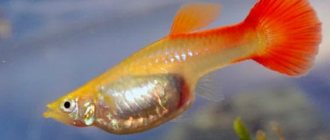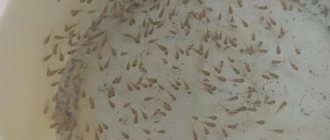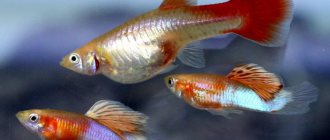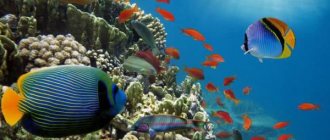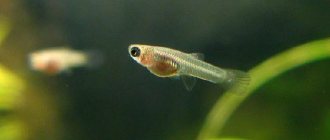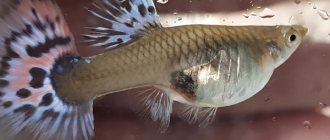How does childbirth occur?
Guppy labor begins at night or in the morning and lasts up to several days. Most often, childbirth occurs without complications. During the reproductive process, guppy fry are released in batches or individually at different time intervals. The fish's tail trembles violently, then freezes, and the babies appear. The behavior of the fry may vary: some of them will be full of energy, while others will be slow and inhibited. The difference is due to the fact that some newborns take time to gain strength.
Why do guppies swim on the surface?
- Question: All my guppies are hanging at the surface of the water and are greedily gulping air.
- Answer: In this case, the answer is on the surface - the fish are suffocating and lack oxygen. Your aquarium may be overcrowded. Connect the aerator as quickly as possible. Keep in mind that oxygen dissolved in water is also consumed during biological filtration, and not only for the respiration of fish and plants. In summer, oxygen consumption increases.
Tips for caring for guppy fry in the first days
Young animals can be left for some time in the spawning tank. If there are a lot of them, it is better to place them in separate aquariums so that they are not crowded. With a lack of free space, various problems arise:
- growth retardation;
- skirmishes between fish;
- rachiocampsis.
Follow these guidelines for caring for guppy fry:
- Pure water. The fry leave a lot of dirt. Therefore, every 10-14 days, replace approximately 20-40% of the water volume. Add snails to the aquarium, which will clean up all the dirt behind the fry.
- Lighting. The duration of daylight hours should be 12-14 hours. On the first day, you can leave the light on overnight.
- Temperature. For young animals, the optimal indicator is +24…+25 ˚С.
- Aeration and filtration. Be sure to install a compressor with a sprayer, especially if there are a lot of fry in the aquarium. If there is a filter, cover it with tulle, otherwise young animals will be drawn inside.
- Nutrition. Feed the fry several times a day. Opt for fine-grained feed. An excellent choice would be dried daphnia, ground to a dusty state, since it floats on the surface of the water for a long time and does not settle, and it is easier for the fry to collect it. Give a live microworm or rotifer, as the young animals need to get protein. For normal growth of the fry, make sure that there is food in the aquarium almost all the time.
Do not use feeders to feed the fry. Scatter food directly on the surface of the water, so no one will go hungry.
When the fry are 12-14 days old, you can begin to accustom them to feeders.
At the age of two weeks, the sex of the young is determined. Females have a characteristic dark spot in the back of the abdomen. Transplant males into a separate aquarium to prevent early pregnancy.
Is it necessary to remove the female for childbirth?
Before giving birth, it is better to remove the female so that the pregnant guppy does not experience stress from the presence of other fish during the process of throwing fry. Removal is also carried out in order to preserve the offspring from being eaten by other inhabitants of the aquarium.
To prevent the guppy from experiencing stress once again, removal is carried out when the fish develops a triangular protrusion in the cloaca area. This sign indicates the imminent (within 1-2 hours) onset of labor.
The fish is moved into a small aquarium (spawning tank) with a volume of 10-15 liters. The water parameters in it should be the same as in the main aquarium. You should not put soil on the bottom - this will keep the water clean longer. It is necessary to place one or several pots with plants in the spawning tank, and also to launch floating greenery - the born fry will hide in it.
On a note! To prevent the female from eating her offspring, just before giving birth, she can be moved to a special small aquarium with holes, which is located in the main spawning area. The holes in its walls do not allow adult fish to escape, but are sufficient for the free passage of fry.
Diseases
The list of diseases of aquarium fish is huge; experienced aquarists and people with special education understand them. If you lack experience, it is better to consult a doctor.
The disease appears in dirty water when the fins are injured. If you ignore the disease, after the destruction of the fins, damage to the body will begin and the fish will die. Fin rot is treated:
- Salt baths. Immerse the sick individual in a solution of table salt (3 tablespoons per 5 liters of water) for 10–15 minutes. Treat the decorations and soil.
- Levomycetin. Dissolve 1 tablet for every 20 liters of water. Once every three days, add a solution in an amount of up to 30% of the aquarium volume. Carry out treatment until complete recovery.
There are many methods for treating fin rot. The treatment is discussed in detail in a separate article.
The disease most often affects males. Remove the parasite-affected areas of the fins with a blade. Place the guppies in salted water (1 g salt per 1 liter). Treat in combination with levomycin (1 tablet per 30 l) or furazolidone (0.5 tablets per 10 l). The course of treatment is 5 days. Remedies for ichthyophthyriosis also help. The tail grows back after some time.
If the spine is curved, and no other symptoms of disease are observed, then the curvature may be congenital. Individuals with scoliosis can lead normal lives, but they are smaller and weaker than healthy guppies. Scoliosis that appears in an adult fish can be corrected by reducing portions during feeding and introducing variety into the diet. During pregnancy, the female monitors the aeration in the aquarium and does not allow inbreeding.
Postnatal behavior of the female
A female guppy that has given birth can eat the fry, so after the birth process is over, it must be separated from the offspring. If the aquarist is sure that the birth is completely completed, the fish can be returned to the general aquarium. If you suspect that there are fry left inside the female, you can move her to a small hatchery with holes placed inside the spawning tank and leave it for another couple of hours.
After giving birth, the female’s behavior quickly returns to normal: she immediately becomes active, begins to look for food, and after some time she can become pregnant again. After mating with one male, guppies are able to bear offspring up to 8 times in a row, so even if the female is separated from the males, she will still be able to give birth to fry.
Childbirth of a guppy: preparation for when you need to place a pregnant fish
For spawning, you can select a separate section in the aquarium, enclosing it with glass, if, of course, its volume allows. But, according to experienced aquarists, a few days before giving birth, it is best to move a pregnant female guppy into a separate small aquarium with a volume of 5–10 liters before throwing. As a last resort, the expectant mother can be moved into a three-liter jar or special plastic containers or trays that can be attached to the aquarium, thereby creating familiar living conditions for the expectant mother. Remember: Severe stress can delay labor.
Using separate containers or aquariums, do not forget to prepare the water and create the necessary conditions for the fish and its offspring.
How to find out and understand that a fish is pregnant?
Guppy pregnancy is the period during which the fish bears fry. At the same time, very often novice aquarists or those who have not kept this type of fish before can easily confuse pregnancy with overeating. Therefore, we will consider the main signs that will allow us to determine that the female is bearing offspring.
It is equally important to know what day the female should give birth and what the guppy’s behavior is before giving birth. This will not only avoid stress, but also protect the fry, since small defenseless fish can simply be eaten by other, more predatory inhabitants of the aquarium.
Pregnant female guppy
Female guppies can become pregnant at the age of 1 month, while full puberty occurs in fish of this species at 3–3.5 months, and at this age females can mate with males. Reproduction of fish can occur in a general aquarium or in a special spawning tank, which must be prepared in advance. How can you tell if a guppy is pregnant? What does a pregnant female guppy look like? Let's consider the main signs of determining pregnancy in females.
It is very easy to determine that a guppy is pregnant visually by external signs and changes in behavior. The expectant mother has a round, large abdomen, which before the birth itself becomes slightly rectangular or takes on a square shape. In addition, due to the enlarged belly, the head of pregnant fish takes on a more graceful shape. You can tell that a guppy is about to give birth by the dark birthmark on its belly. The outline or black eyes of the fry may be visible through the thin skin on the peritoneum.
Note that in some varieties of guppies (endlers) the maternity spot is less noticeable, the tummy does not take on a square shape, but the swelling before birth remains unchanged.
Important! The behavior of not only female guppies changes before giving birth, but also males. A fish bearing offspring behaves more calmly and peacefully in the aquarium. Males actively swim after females, poking their noses into the abdomen. Before giving birth, females show anxiety, try to hide in algae, secluded corners or other shelters in the aquarium, and swim closer to the bottom.
Immediately before giving birth, females develop a small triangle on the cloaca. Having noticed this, you should separate the fish from the rest of the inhabitants of the aquarium. In about an hour or two, she will begin giving birth (spawning).
Guppy a few days before giving birth
Guppy a few days before giving birth
If the female is not separated and separated from other aquarium inhabitants, if there are no thick algae or decorative coverings in the aquarium, the fry will be eaten within the first two days.
Considering all the above signs, you can understand that the female guppy is pregnant. This will help prepare for childbirth.
Compatibility with other fish
Guppy fish are very friendly fish and can get along with other fish species in the same aquarium. But their neighbors must also be friendly and peaceful, otherwise the Guppies can easily be eaten or intimidated. Various colorful fish can be excellent neighbors: Norman's blue-eye; Neon; Mollies; Swordtails; Danio; catfish.
Bad neighbors can be: Cichlids; Cockerels (Cockerel may perceive a male Guppy as a male Cockerel and become aggressive).
Guppy fish species
There are quite a large number of species of Guppy fish. Here are the most common Guppies: Fantails; Veil; Voile-scarf; Green; Carpets; Red-tailed Half-black; Round-tailed; Tape; Ribbon-scarf; Semi-black; Mesh; Mesh gold; Smaragdaceae; Emerald gold; Scarf ones.
Version 2. Self-preservation instinct
A mother guppy may perceive her fry as competitors for food.
As surprising as it sounds, a mother can eat her cubs, obeying the instinct of self-preservation. The babies are perceived by the female, again, not as her children, but as competitors in the fight for food and possibly territory. Despite their peaceful disposition, guppies are not too lazy to exterminate small competitors . In the world of fish, everything that is smaller than you is prey, even if they are your own fry. As they say, whoever had time, got to eat.
Pregnancy in guppy fish
The temperature of the habitat should not exceed 26 degrees. If a pregnant female senses any danger, the birth may be delayed indefinitely. Too high a stress threshold can lead to spontaneous miscarriage. Therefore, it is important not only to detect pregnancy in a guppy in time, but also to create appropriate conditions for caring for her during the period of gestation:
- Monitor the water temperature.
- Change the water on time, clean it of excess food or its residues.
- Adjust the presence and level of ammonia in the water.
Spawning tray for breeding aquarium fish.
If she gets sick, it will definitely affect her offspring. It is advisable to feed her with live food, this will protect her body, prevent deformation of the fry, and maintain pregnancy . Live food contains a lot of protein, and it has a beneficial effect on both the condition of the female and the health of the fry.
If possible, purchase a special tray for pregnant fish. It is attached to the aquarium (inside) and serves as a secluded place for the pregnant fish, without depriving it of its usual environment. Without creating unnecessary stress. If this is not possible, then you can divide the aquarium with a fine grid, so she will feel calm and the males will not chase the pregnant guppy.
The necessary conditions
Aquarium fish do not require human participation to procreate. This natural course of events is sometimes completely invisible to prying eyes. However, many aquarists are interested in breeding, and for them, breeding guppies at home is an exciting activity. Gupiks are unpretentious, but a favorable result largely depends on care and environmental parameters.
Optimal conditions:
- Maturity of fish. To begin breeding, guppies must grow up and reach four months of age. By this time, the females will be quite ready to bear and give birth to offspring.
- Water quality. Hardness should be no more than 15 units, acidity pH from 6.0 to 8.5, without sharp fluctuations. If the tap water meets these parameters, there is no need to specially prepare it. You can improve the quality of acidic water using coral chips or a special branded product.
- Water temperature. To speed up puberty and stimulate the instinct of procreation in fish, it is necessary to keep them in warm water - at least 25ºC. When the temperature rises to 30ºC, the guppies move closer together more actively.
- Consumption of live food. Bloodworms, tubifex, and insects contain proteins necessary for the sexual activity of fish.
Don’t forget about lighting: the presence of lighting is an additional incentive for reproduction. When exposed to light, the color intensity of males increases, which makes them more attractive to females.
Why do guppies freeze in the corner of the aquarium?
- Question: Guppies are too lethargic. They freeze in one place for a long time: in the corner of the aquarium near the surface, near the water flow of an aquarium filter or the air flow from a compressor. It seems that he has difficulty staying in a horizontal position - he wiggles his whole body violently. The dorsal fin and tail of the guppy are compressed as much as possible. Pays almost no attention to food. Only sometimes, as if with the last of his strength, he picks up a piece, but immediately spits it out.
- Answer: This is a real problem. And a problem clearly related to water quality. Either you have a new, recently launched aquarium with an unstable biobalance, or you simply neglect regular replacements.
- Guppies do not tolerate old water well. In addition, such symptoms begin to appear with any disturbance in the biobalance: when a whole group of new fish is introduced at the same time, during overpopulation, during insufficient operation of the filter, which simply cannot cope with toxins (ammonium, nitrates) and they poison the aquarium and all its inhabitants.
- If your guppy starts to behave this way, get ammonium tests done as soon as possible and, in any case, put fresh carbon in the filter canister. If the level of toxic substances exceeds, use any suitable aquarium chemical (for example, sera bio nitrivec ).
Reproduction problems
Quite often, guppies become the subject of selection, and how unpleasant it is for a beginning breeder to face problems in this matter. For breeders and just hobbyists, important information about diseases associated with the reproduction of guppies.
Infertility
Symptoms: females are unable to produce offspring, their color becomes dull, red and all its shades are especially noticeably lost. Reasons: too long daylight hours in the aquarium or too powerful lighting.
Treatment: Unfortunately, it is impossible to cure infertile females. This process is irreversible, but by identifying and correcting the cause, you can expect that the sick guppies will regain their bright color, and the next generation of females will not suffer the same fate.
Hermatophrodiism
Symptoms: not externally noticeable. In females, for unknown reasons, along with the female internal genital organs, male testes develop. There are known cases of self-fertilization. The offspring in this case most often consists of bisexual females and sterile males. The causes and treatment of this disease are currently unknown.
The fish's back is curved to the side
This is most likely the result of severe overcrowding in your aquarium. Make room. For simplicity, remember this formula: for a 3.5 cm fish you need 5 liters of water. This formula is not the ultimate truth, but it can and sometimes even should be taken as a basis.
Another cause of this unpleasant phenomenon may be tuberculosis or mycobacteriosis; this, unfortunately, is one of the most common causes. It is possible to fight fish tuberculosis, although it is quite difficult and quite rarely brings positive results, but first of all, if this dangerous disease is suspected, the crooked fish must be isolated. In addition to the curved spine, the sick guppy's eyes turn black, the fish loses weight, sucks in its stomach, and changes its behavior. Remember that if a fish catches tuberculosis once, it will never become completely healthy, and the disease will most likely return again sooner or later.
Water that is too hard can adversely affect both the spine of adult guppies and their fry. For guppies, the required water hardness is 12.0 - 18.0hD.
There are many reasons why a baby guppy’s spine is bent, but unfortunately you no longer have the opportunity to change the situation. You can get rid of the sick fish or leave it in the aquarium, but you definitely need to find the cause and prevent the curvature in the future.
- Injury. The little guppek could have suffered a back injury, both in the mother’s womb and in the first days/hours after birth. Place plants at the bottom of the hatchery.
- Starvation. Lack of mineral salts, oxygen starvation, poor diet of the female - mother or fry. To avoid this situation, make sure your guppies eat properly. Fry should be fed with finely ground live food, and adults should not be kept on dry concentrates from the pet store alone.
- Inbreeding. Remember that too close inbreeding can not only strengthen the desired qualities of the fish, but also weaken the health of future offspring.
Nutrition
What do guppy fish eat? These little ones are omnivores; they will eat special dry food and live food. It is better to purchase dry food for fish from well-known manufacturers. As an option - in bulk form. All-purpose flakes will be the best diet for guppies. Among live food, fish prefer bloodworms, daphnia, brine shrimp, cyclops, and tubifex.
How many times should you feed your guppies? One rule should be remembered: you cannot overfeed fish. It is preferable to feed adult fish twice a day, morning and evening. Portions should be small, and if the food is flake, knead it with your fingers for the guppy’s convenience.
By the way, mini-flakes have now appeared specifically for small fish. They are ideal for baby guppies.
When purchasing dry food, be sure to look at the expiration date. If the food is purchased by weight, it can be stored for up to two months. The food bag must be tightly closed after each feeding of the fish.
Genera of guppy fish
Before giving birth, the guppy develops a black spot in the anal fin area.
Females give birth 28-40 days after fertilization. This depends on the characteristics of the female, the age of the conditions in which she is located, and stress resistance. Before spawning, pregnant females begin to tremble a little, move little, and may lose their appetite. If the water container or aquarium is equipped with a heater, then the pregnant guppy lies on the bottom most of the time, and it is near it that this can serve as a signal that they are about to start giving birth.
Childbirth lasts differently - from several hours to several days. When the time has come, their tail first trembles violently, then freezes for a moment. It is at this moment that the process of throwing the fry - birth - occurs. The next day, the female can be placed back in the aquarium so that she does not eat the fry if she was removed from the general environment . Malek, just born, immediately shows his activity and independence. It is advisable to isolate the children until they grow up so that they are not eaten by adults. Or put climbing algae, shells, stones and other objects with recesses, holes, cracks in the aquarium so that they can hide there.
Caring for guppies is easy, the fish themselves are unpretentious. They get along well and reproduce in any conditions, even in a three-liter jar. So the main thing you need to successfully breed guppies is desire and patience.
How do guppies mate?
Guppies do not swim very fast, so it is easy to notice that they are in mating season: at this time, their movement speed increases. Small males begin to chase the females and try to snuggle up to their sides. Guppies mate using the gonopodium, a tube-shaped anal fin. Thanks to the movable structure of this genital organ, seminal fluid flows directly into the abdominal cavity of the female - this is how fertilization occurs.
One of the most important conditions for reproduction is that for every male guppy in the aquarium there must be at least two females. If there are more males, they can drive the female until exhaustion and even death. It is advisable that there are no aggressive neighbors nearby, otherwise they will pinch the guppies, preventing them from mating. It is optimal when the male and female are in a separate container.
This is interesting! Having mated once, a guppy can become pregnant and give birth several times in a row.

